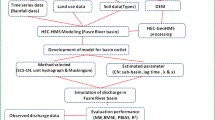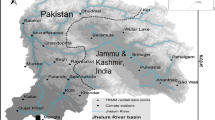Abstract
Reliable predictions of storm runoff from rainfall and snowmelt are important for flood hazard mitigation and resilience. In this study, the HEC-HMS and PRMS hydrological models have been applied to simulate storm runoff in Taunton River Basin for the storm event in 2010 when maximum rainfall intensity reached approximate 5 in/day in March, and the snowfall reached about 11 inches in December. Model parameters were calibrated, and model performance was evaluated by comparing model-simulated daily stream flow with observations. For the rainstorm period during March–April, results indicate that both HEC-HMS and PRMS provide very good predictions of rainfall runoff with the correlation values above 0.95, and PRMS produces lower root-mean-square errors than those from HEC-HMS. Over the 12-month period including the snowfall in December, the time series of flow by PRMS match better with observations than those from the HEC-HMS. The 12-month overall correlation values for HEC-HMS and PRMS are 0.91 and 0.97 at Bridgewater Station, and 0.89 and 0.97 at Threemile Station, respectively. For an extreme storm scenario of the maximum historical 36.7-inch snowfall in early February in combination with the rainstorm in March–April of 2010, model simulations indicate that the flow would substantially increase by about 50% or more. Comparisons between HEC-HMS and RPMS models have been analyzed to provide references for storm runoff modeling.


(source National Weather Service, USA)










Similar content being viewed by others
References
Amengual A, Romero R, Alonso S (2008) Hydro-meteorological ensemble simulations of flood events over a small basin of Majorca Island, Spain. Q J R Meteorol Soc 134:1221–1242
Anderson ML, Chen ZQ, Kavvas ML, Feldman A (2012) Coupling HEC-HMS with atmospheric models for prediction of watershed runoff. J Hydrol Eng 7(4):312–318
Beighley RE, Melack JM, Dunne T (2003) Impacts of California’s climatic regimes and coastal land use change on streamflow characteristics. J Am Water Resour 39(6):1419–1433
Beighley RE, Eggert KG, Dunne T, He Y, Gummadi V, Verdin KL (2009) Simulating hydrologic and hydraulic processes throughout the Amazon River Basin. Hydrol Process 23:1221–1235
Chang H, Jung IW (2010) Spatial and temporal changes in runoff caused by climate change in a complex large river basin in Oregon. J Hydrol 388(3–4):186–207
Chen C, Huang W (2013) Hydrological modeling of typhoon-induced extreme storm runoffs from Shihmen watershed to reservoir, Taiwan. Nat Hazards 67(2):747–761
Chen Y, Ren Q, Huang F, Xu H, Cluckie I (2011) Liuxihe model and its modeling to river basin flood. J Hydrol Eng 16(1):33–50
Chow VT (1959) Open channel hydraulics. McGraw-Hill Book Company, New York
Christiansen DE, Markstrom SL, Hay LE (2011) Impacts of climate change on growing season in the United States. Earth Interact 15(33):1–17
Cunderlik JM, Simonovic SP (2007) Inverse flood risk modeling under changing climatic conditions. Hydrol Process 21(563):577
Dressler KA, Leavesley GH, Bales RC, Fassnacht SR (2006) Evaluation of gridded snow water equivalent and satellite snow cover products for mountain basins in a hydrologic model. Hydrol Process 20(4):673–688
Du SQ, Shi PJ, Van Rompaey A, Wen JH (2015) Quantifying the impact of impervious surface location on flood peak discharge in urban areas. Nat Hazards 76(3):1457–1471
Gaytán R, Anda J, Nelson J (2008) Computation of changes in the runoff regimen of the Lake Santa Ana watershed. Lakes Reserv Res Manag 13:155–167
Goleij H, Haghiabi AH, Parsaie A (2017) An experimental study on plunging depth of density currents. Front Struct Civ Eng. https://doi.org/10.1007/s11709-017-0417-7
Halwatura D, Najim MMM (2013) Application of the HEC-HMS model for runoff simulation in a tropical catchment. Environ Model Softw 46:155–162
Hay LE, Wilby RL, Leavesley GH (2000) A comparison of delta change and downscaled GCM scenarios for three mountainous basins in the United States. J Am Water Resour As 36:387–397
Hay LE, Leavesley GH, Clark MP, Markstrom SL, Viger RJ, Umemoto M (2006a) Step-wise, multiple objective calibration of a hydrologic model for a snowmelt-dominated watershed. J Am Water Resour 42(4):877–890
Hay LE, Leavesley GH, Clark MP (2006) Use of remotely sensed snow-covered area in watershed model calibration for the Sprague River. In: Oregon in joint 8th federal interagency sedimentation conference and 3rd federal interagency hydrologic modeling conference, 2–6 April 2006, Reno, Nevada
HEC-HMS User Manual (2016) Hydrologic modeling system (HEC-HMS) user manual: version 4.2.0., USACE (U.S. Army Corps of Engineers), Hydrologic Engineering Center, Davis, CA
IPCC Report (2013) Climate change 2013: the physical science basis. http://www.climatechange2013.org/
Knebl MR, Yang ZL, Hutchison K, Maidment DR (2005) Regional scale flood modeling using NEXRAD rainfall, GIS, and HEC-HMS/RAS: a case study for the San Antonio River Basin Summer 2002 storm event. J Environ Manag 75(4):325–336
Laouacheria F, Mansouri R (2015) Comparison of WBNM and HEC-HMS for Runoff hydrograph prediction in a small Urban Catchment. Water Resour Manag 29(8):1–17
Li JF, Chen YD, Zhang L, Zhang Q, Chiew FHS (2016) Future changes in floods and water availability across China: linkage with changing climate and uncertainties. J Hydrometeorol 17(4):1295–1314. https://doi.org/10.1175/JHM-D-0074.1
Markstrom SL, Niswonger RG, Regan RS, Prudic DE, Barlow PM (2008) GSFLOW—coupled ground-water and surface-water flow model based on the integration of the precipitation-runoff modeling system (PRMS) and the modular ground-water flow model (MODFLOW-2005). Techniques and methods 6-D1. U.S. Geological Survey, Reston, Viginia
Markstrom SL, Hay LE (2009) Integrated watershed scale response to climate change for selected basins across the United States. Water Resour Impact 11(2):8–10
Markstrom SL, Regan RS, Hay LE, Viger RJ, Webb RMT, Payn RA, LaFontaine JH (2015) PRMS-IV, the precipitation-runoff modeling system, version 4: U.S. Geological survey techniques and methods, book 6, chap. B7. https://pubs.usgs.gov/tm/6b7/
McLin SG, Springer EP, Lane LJ (2001) Predicting floodplain boundary changes following the Cerro Grande wildfire. Hydrol Process 15:2967–2980
Meenu R, Rehana S, Mujumdar PP (2013) Assessment of hydrologic impacts of climate change in Tunga-Bhadra river basin, India with HEC-HMS and SDSM. Hydrol Process 27(11):1572–1589
Mandal A, Stephenson TS, Brown AA, Campbell JD, Taylor MA, Lumsden TL (2016) Rainfall-runoff simulations using the CARIWIG simple model for advection of storms and hurricanes and HEC-HMS: implications of Hurricane Ivan over the Jamaica Hope River watershed. Nat Hazards 83(3):1635–1659
Neshaei MAL, Ghanbarpour F (2017) The effect of sea level rise on beach morphology of Caspian sea coast. Front Struct Civ Eng. https://doi.org/10.1007/s11709-017-0398-6
Onusluel GG, Harmancioglu N, Gul A (2010) A combined hydrologic and hydraulic modeling approach for testing efficiency of structural flood control measures. Nat Hazards 54(2):245–260
Najafi MR, Moradkhani H, Jung IW (2011) Assessing the uncertainties of hydrologic model selection in climate change impact studies. Hydrol Process 25(18):2814–2826
Niswonger RG, Allander KK, Jenton AE (2014) Collaborative modelling and integrated decision support system analysis of a developed terminal lake basin. J Hydrol 517:521–537
Tian Y, Zheng Y, Wu B, Wu X, Liu J, Zheng CM (2015) Modeling surface water–groundwater interaction in arid and semi-arid regions with intensive agriculture. Environ Model Softw 63:170–184
USACE (U.S. Army Corps of Engineers) (2010) Snowmelt modeling in HEC-HMS. Flood and Coastal Storm Damage Reduction R&D Program, Engineering Center, Davis
US EPA (2015) BASINS 4.1 (Better Assessment Science Integrating point & Non-point Sources) Modeling Framework. National Exposure Research Laboratory, RTP, North Carolina. https://www.epa.gov/exposure-assessment-models/basins. Accessed 1st Jan 2016
Verdhen A, Chahar BR, Sharma OP (2013) Snowmelt runoff simulation using HEC-HMS in a himalayan watershed. In: World environmental and water resources congress 2013: showcasing the future 3206–3215
Wu B, Zheng Y, Wu X, Tian Y, Han F, Liu J, Zheng CM (2015) Optimizing water resources management in large river basins with integrated surface water–groundwater modeling: a surrogate-based approach. Water Resour Res 51(4):2153–2173
Yates D, Warner TT, Brandes EA, Leavesley GH, Sun J, Mueller CK (2001) Evaluation of flash-flood discharge forecasts in complex terrain using precipitation. J Hydrol Eng 6(4):265–274
Yilmaz AG, Imteaz MA, Ogwuda O (2012) Accuracy of HEC-HMC and LBRM models in simulating snow runoffs in upper Euphrates Basin. J Hydrol Eng 17:342–347
Wang D, Hagen SC, Alizad K (2013) Climate change impact and uncertainty analysis of extreme rainfall events in the Apalachicola River basin, Florida. J Hydrol 480(2013):125–135
Zarriello PJ, Bent GC (2011) Elevation of the March–April 2010 flood high water in selected river reaches in central and eastern Massachusetts: U.S. Geological Survey Open-File Report 2010–1315
Zarriello PJ, Ahearn EA, Levin SB (2012) Magnitude of flood flows for selected annual exceedance probabilities in Rhode Island through 2010 (ver. 1.2, revised 27 Mar 2013): U.S. Geological Survey Scientific Investigations Report 2012–5109. http://pubs.usgs.gov/sir/2012/5109
Zhang Q, Chen YD, Chen XH, Li JF (2011) Copula-based analysis of hydrological extremes and implications of hydrological behaviors in the Pearl River Basin, China. J Hydrol Eng 16(7):598–607. https://doi.org/10.1061/(ASCE)HE.1943-5584.0000350
Websites
HEC-HMS model: http://www.hec.usace.army.mil/software/hec-hms/
PRMS model: https://wwwbrr.cr.usgs.gov/projects/SW_MoWS/PRMS.html
Snowfall To Rainfall Calculator: http://www.csgnetwork.com/snowraincvt.html
Snow to Water Ratios: https://spacemath.gsfc.nasa.gov/earth/88Mod11Prob1.pdf
EPA BASINS model https://www.epa.gov/exposure-assessment-models/basins
Snowfall records, Providence, Rhode Island. Assessed 12 Mar 2017. https://weather.com/news/news/new-england-boston-record-snow-tracker
Acknowledgements
This study is supported in part by the Coastal Resilience Center, Department of Homeland Security, through the University of North Carolina. The authors also thank the advices for snowmelt modeling in HEC-HMS by Tom Brauer and Mike Bartles at Hydrologic Engineering Center of U.S. Army Corps of Engineers.
Author information
Authors and Affiliations
Corresponding author
Rights and permissions
About this article
Cite this article
Teng, F., Huang, W. & Ginis, I. Hydrological modeling of storm runoff and snowmelt in Taunton River Basin by applications of HEC-HMS and PRMS models. Nat Hazards 91, 179–199 (2018). https://doi.org/10.1007/s11069-017-3121-y
Received:
Accepted:
Published:
Issue Date:
DOI: https://doi.org/10.1007/s11069-017-3121-y




